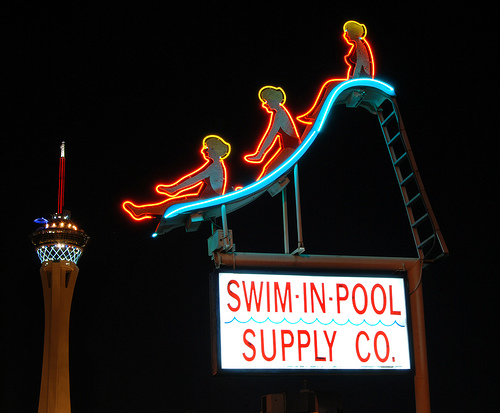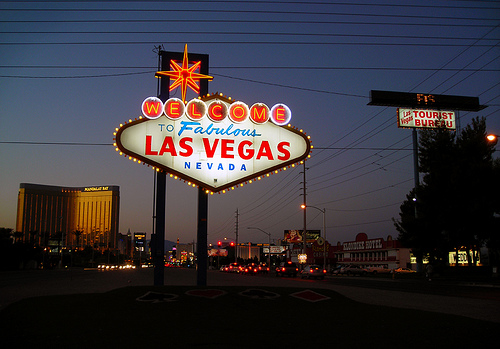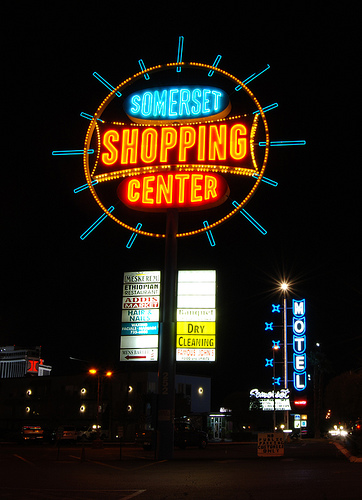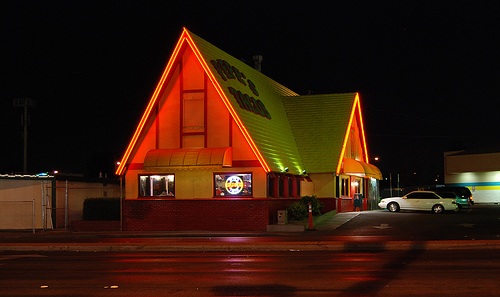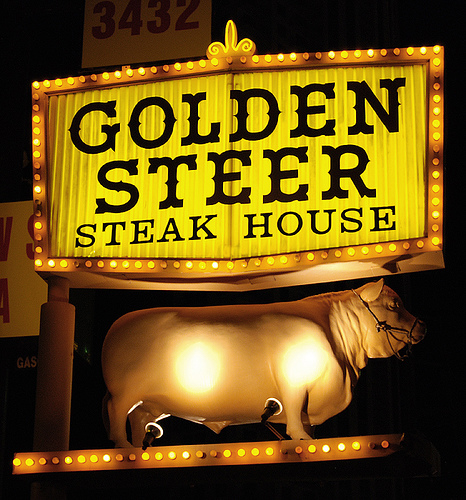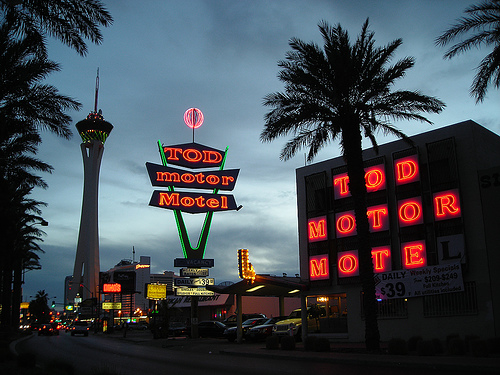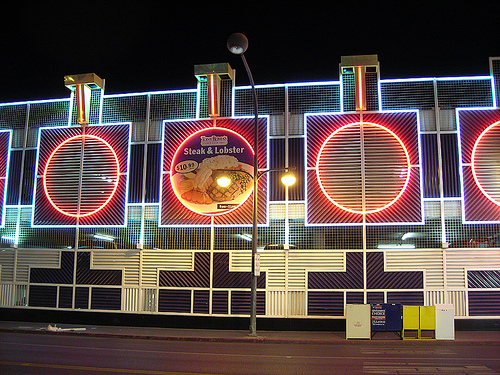Of course, the most noticeable change in Las Vegas has been the explosive growth of its population--it's hard to believe that 2 million people live in Clark County, and most of those live in Las Vegas. I feel two ways about this.
On the one hand, I hate the traffic, the crowds, the inflation in our cost of living, the disregard for our environment, and the endless blocks of boring, overpriced houses and elitist high-rises.
On the other hand, I can remember when B. Dalton Bookseller was the only bookstore in town, and the cultural and social resources were few and far between. I like the great variety of restaurants, nightclubs, arts events and art galleries we have now. What I dislike the most--and I think this is at the very bottom of our problems--is the complete corporate control of state and local government that long ago separated Las Vegas citizens from their city.
You conducted a number of interviews with men who worked on Boulder (Hoover) Dam and many of the people who helped establish Boulder City. How did you get interested in preserving their stories and their history?
Growing up in Boulder City, I listened intently to the stories told about construction of Hoover Dam told by the men and women who were there. It's not often someone young has the opportunity to hear first-hand accounts of a transformative historical event. I didn't waste that opportunity; when I was old enough to know what's what and what to do about it, I started recording the stories and collecting the material to document construction of the dam, of Boulder City, and of lower Colorado River development that made such places as Las Vegas viable. I just always knew that this was the niche I had to fill.
What was the biggest obstacle to starting the collection that became the basis for the Boulder Dam Museum?
One of the greatest opportunities I had in my "career" as a Hoover Dam historian was helping build the library and archive for the Boulder City Museum and Historical Association. As I noted earlier, I'd begun recording and collecting around the time I was a teenager, and in college began doing research and writing on the subject in earnest.
But I have to admit there really were no obstacles in my pursuit. Having been born in Boulder City and raised there, I was friends with all the people who told me their stories and gave me their stuff--I had a significant role in the tribe, so to speak. I was trusted and I worked very hard to impress on these people how important their lives were, how important it was that their stories be saved, and how important it was that their artifacts be preserved and made available.
So, by the time the Association asked me to work for them in June 1997, everything was in place to make the archive happen. I donated everything I'd collected, and obtained many large and important collections from such Boulder City/Hoover Dam boosters as Elton Garrett, Teddy Fenton, Esther Shipp, descendents of Hoover Dam medic "Doc" Jensen and Bureau of Reclamation office engineer John Page, and many, many others. I gave them all a sense they were themselves helping to build this important archive, that it was a joint project, and not just something I was doing myself.
Eventually, the library and archive at the Boulder City Museum and Historical Association, became the go-to resource for anything to do with construction of Hoover Dam and Boulder City, and development activities on the lower Colorado River. The Bureau of Reclamation and the National Park Service came to us; researchers, documentary filmmakers, students, people looking for ancestors who worked on the dam came to us. I was very proud of what we did and that we were able to help so many people with their work.
As the current Curator of History at the Nevada State Museum, what do you find most interesting in the collection?
I left Boulder City in 2007 to assume a new job as Curator of History and Collections at the Nevada State Museum, Las Vegas [NSMLV]. The collections here are focused more widely than the collections in Boulder City.
What interests me most is the photograph collection. When I was negotiating for this job, working with the photo collection was an issue I was adamant about; in fact, if I had not been assured of my work with the photographs, I likely would not have taken the job. NSMLV's photo collection has not been very accessible and needs a tremendous amount of work in making it available and publicizing it. There's some absolutely amazing stuff in there.
One collection in particular comes from photographer Jay Florian Mitchell. There are thousands of images that document every aspect of life in Las Vegas from the mid-1950s through the early 1970s. I've been working to publicize that collection and am getting more successful as public interest increases. An upcoming documentary on the history of the Moulin Rouge Hotel and Casino is using dozens of images from the Mitchell Collection. Mitchell's photos have been used in a couple of museum events on Mid-Century Modern Las Vegas, and I'm working toward getting these photos out there in several other venues.
We also have Cliff Segerblom's collection here--another couple of thousand images of Las Vegas, Hoover Dam, Lake Mead, the Colorado River, and other sites throughout the state. Cliff was best known as an artist--many are familiar with his painting, his "fine art," but not his photography. There are some gorgeous images in that collection; there's an upcoming event at the Las Vegas Springs Preserve--March 15, I think, but check--to exhibit Cliff's photos, all of which are taken from the collection at the Nevada State Museum, Las Vegas.
Aside from those two large collections, we're quietly building an impressive archive of photographs of Helen J. Stewart and her family, of the Las Vegas Ranch, etc. Reaching out to descendents, making them feel they're helping to build something important for the future. It's so important to make people feel welcome and involved, and to convince them that before they toss something in the garbage because they don't believe it's important--PLEASE!--give us a chance to save it. Call me! 1-702-486-5205, x224
What part of Southern Nevada history intriques you the most?
These days, the part of Southern Nevada history that intrigues me most is the development of the gay community. I've been working in that field since about 1975, have built a solid archive [deposited in the Special Collections Department of the UNLV library], conducted dozens of oral history interviews, and have been producing articles for many years, nearly all of them in the state's gay press.
BUT--the Nevada Historical Society Quarterly [Summer 2009 issue, just released] has published "Stonewall Park," an article I wrote about efforts in the 1980s to establish a gay town in Nevada. Gay studies has been a "legitimate" field of scholarly research for decades, eveywhere--except in Nevada. This article in the Quarterly breaks that barrier, so it will be interesting to see where it leads.
When will you begin moving over to the new building at the Springs? When do you expect it to open? Will the exhibits be different and if so, how?
When will we be moving over to our new building at the Las Vegas Springs Preserve? The new building--and it's beautiful!--has been finished for several months, and construction of the permanent exhibits should commence in February.
That ought to take about another year, during which we'll be moving collections over from the Lorenzi Park building into the new place. It's hard to say at this point whether there will be staff and funds to run the new museum, or to operate and maintain the building.
The Division of Museums and History took a 20% cut during the last legislative session, and with a special session looming in February during which deeper cuts to state budgets will be made, none of us knows what might happen. The new state museum in Las Vegas has the potential to become a cultural jewel--but whether there's the political will and economic means to make that happen remains to be seen.


